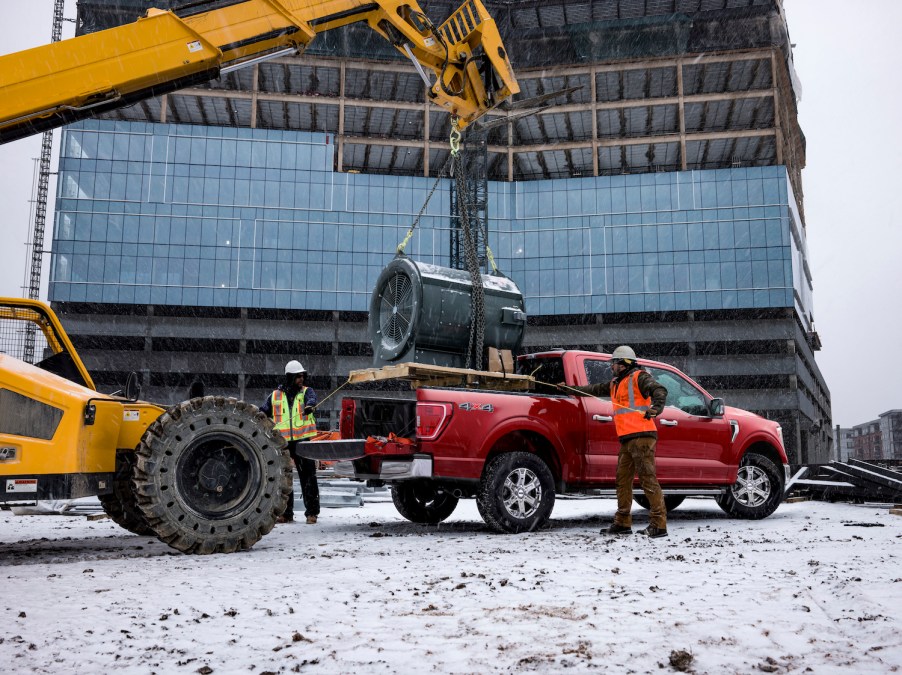
Can a Half-Ton Truck Only Carry 1,000 Pounds?
Back when I was a kid, a rather rotund friend of my dad’s stopped by to show off his brand new “half-ton” pickup truck. I counted four doors and six seatbelts and did some math. Later, I asked my dad whether his friend could give five equally burly buddies a ride, or if exceeding 1,000 pounds would damage his “half-ton” truck. Once my dad had stopped laughing he explained that “half-ton” is outdated slang for the light-duty class of full-size pickup trucks: 1,000 pounds may be half of a ton, but modern half-ton trucks can handle much more weight.
How much can a half-ton truck carry?
Because “half-ton” is outdated slang for the full-size, light-duty pickup truck class, modern “half-tons” can all carry much more than half a ton. In fact, some properly equipped light-duty trucks can carry more than a full ton of payload.

If you order a full-size pickup truck with just two doors, a short bed, and a base engine, it will have a relatively low payload capacity. A stripped-down Ford F-150 comes with a payload rating of just 1,310 pounds. That’s less than Ford’s Maverick!
Many fully-optioned “half-ton” trucks can, confusingly, carry a full ton. Remember, payload capacity includes passengers and gear in the cab as well as cargo in the bed and your trailer’s tongue weight. But payload capacity is separate from towing capacity. Here are the actual payload capacities of the six full-size, light-duty pickup trucks available.
| Pickup Truck Make / Model | Payload Capacity |
| 2022 Nissan Titan | 1,311 – 1,711 pounds |
| 2022 Ford F-150 | 1,310 – 2,238 pounds |
| 2022 GMC Sierra 1500 | 1,360 – 2,270 pounds |
| 2022 Toyota Tundra | 1,745 pounds – 2,290 pounds |
| 2022 Chevrolet Silverado 1500 | 1,480 – 2,300 pounds |
| 2022 Ram 1500 | 1,225 – 2,325 pounds |
Where does the phrase ‘half-ton truck’ come from?
The U.S. Army first used large trucks for transport and classified them by tonnage. Perhaps this is why Ford referred to its first Model T truck as the “one-ton Model TT chassis.” During WWII, the military distinguished quarter-ton (Willys Jeep) and half-ton (Dodge WC series) vehicles from its cargo-hauling one-tons.

Mike Magda at PickupTrucks.com speculates that automakers began using the phrase “half-ton” to advertise pickup trucks to veterans familiar with half-ton military trucks such as the Dodge WC. These trucks, namely the Ford F-1, the Dodge D/W100, and General Motors’ “Series” pickups carved out an important market niche: the full-size, light-duty truck.
Over time, these trucks morphed into the Ford F-100/150, the Chevrolet C/K series, and eventually the Dodge Ram pickups. Then GM and Chrysler Corporation tried to one-up Ford by adding an extra 0 to their truck names and the modern “1500” was born. This is how the Ram 1500 got its name.
At the same time, these trucks competed by one-upping each others’ capabilities. This led to an “Our half-ton can haul more than your half-ton” sort of competition. And soon, all the “half-tons” had left the 1,000-pound payload capacity far behind.
What defines a half-ton truck?
“Half-ton” is slang for full-size, light-duty pickup trucks. These trucks are the size of their heavy-duty big brothers but are engineered to haul and tow less. They all fit into the government’s “2b” truck class which means their combined vehicle and max payload weight is under 8,501 pounds.

According to the U.S. Department of Energy, trucks are classified by their gross vehicle weight rating (GVWR). This is the combined weight of the vehicle and its highest-rated payload.
Market demands push pickup trucks from multiple manufacturers into similarly-sized groups. For example, all the midsize trucks have GVWRs under 6,000-pounds and fall into Class 1.
Likewise, full-size light-duty trucks are prized by consumers as comfortable daily drivers with a strong road presence and a fair amount of truck capability. These “half-ton” trucks all fall into a GVWR between 6,000 and 8,500 pounds, putting them in Class 2a.



